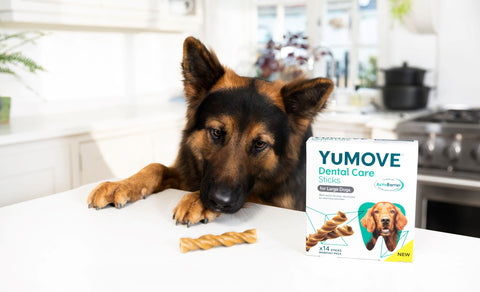

Spotting the early signs of periodontal disease in dogs
By Dr Sarah-Jane Molier MRCVS
Periodontal disease – otherwise known as gum disease – is one of the most diagnosed diseases in dogs. In fact, over 80% of dogs by the age of two have periodontal disease. The good news? It’s completely preventable. So, how do you know if your dog has gum disease and what can you do about it? Let’s take a closer look…
What is periodontal disease in dogs?
Periodontal disease is inflammation of the tissues surrounding the teeth. ‘Periodontal’ refers to the periodontium (the structure that supports a tooth). These include the:
- Gingiva – gums
- Cementum – layer of calcium on the root of the tooth
- Periodontal ligament – a rubbery band that attaches the tooth to the bone socket
- Alveolar bone – the bone surrounding the teeth, which forms the tooth socket
Periodontal disease is a progressive disease, meaning it gets worse over time. It starts with inflammation of the gums, then extends deeper into the tissues and bone surrounding the teeth.
What causes canine periodontal disease?

Bad bacteria are the culprit here! Bacteria build up on the teeth causes plaque (a sticky film of bacteria). The body tries to attack the bacteria by sending white blood cells to the area, resulting in inflammation. This is known as canine gingivitis.
If left untreated, the plaque hardens and forms tartar – technically known as calculus. Bad bacteria sticks to tartar really easily, so more plaque builds up and the cycle never ends. With time, the structures supporting the teeth also become inflamed and diseased – and in serious cases, gum disease can cause early tooth loss in dogs.
Certain dog breeds are particularly prone to gum disease. Find out which dogs are susceptible to dental issues now.
Spotting the signs
Unfortunately, there are no obvious early signs. And a dental issue is often diagnosed too late. Once signs become apparent, they include:
- A thin red line where the gum meets the tooth
- Red and swollen gums
- Bad breath
- Visible tartar
- Bleeding gums when brushed
In more advanced stages of disease, the symptoms include:
- Drooling
- Blood drops in your dog’s food or water bowl
- Chewing on one side of the mouth
- Dropping food while eating
- Preferring soft food over kibble
- Pawing at the mouth or rubbing their face on the floor
- Changes in behaviour, unusual aggression, or becoming head shy
- Swelling on the face
- Receding gums
It’s important to note that most dogs will continue to eat normally with periodontal disease, even though the gums are sore. After all, dogs aren’t put off their food easily. Is periodontal disease in dogs painful? Absolutely. They just can’t tell you.
That’s why it’s so important to make dental checks part of your daily routine, if your dog lets you. Gently lift their gums and take a look around. If you notice any of these signs, or anything else unusual about your dog’s mouth, then you should see a vet as soon as possible.
How to treat periodontal disease in dogs

Once your dog has developed periodontal disease, this can only be treated by a vet. Home care can help prevent plaque build-up and therefore help prevent gum disease, but it cannot reverse what’s already happened.
Luckily, gingivitis (the earlier stage of the disease) is reversible with a scale and polish by your vet. It’s only in the more advanced stages where the disease cannot be reversed. But the right treatment can slow or halt its progression.
Treatment for periodontal disease in dogs includes:
- Assessing the extent of the disease with a full oral exam under general anaesthetic, including probing for pockets in the gums and taking dental X-rays
- Scale and polish under general anaesthetic, to allow cleaning below the gumline
- Tooth extractions
What happens if you don’t treat periodontal disease in dogs?
If left untreated, periodontal disease can lead to tooth root abscesses, fistulas (holes) between the mouth and nose, eye problems, osteomyelitis (bone infections) and jaw fractures.
Advanced periodontal disease can cause problems all over the body – not just in the mouth – such as:
- Internal organs. Bad bacteria can travel through the bloodstream to the organs, particularly affecting the liver, kidneys and heart.
- The stomach. If your dog swallows the bad bacteria that lives in the mouth, it can cause harm to their digestive system.
- Your dog’s skin. When dogs have a scratch or bump on their body, they lick at it. So, if your dog has lots of bad bacteria in the mouth, it can actually cause skin problems.
How can I improve my dog’s gum health?
The most important thing to remember is periodontal disease in dogs is preventable. But how can you prevent it? Here are our top tips for improving your dog’s dental health:
- Take your dog for regular dental checks at your veterinary clinic (every 6–12 months). They will advise how often your dog needs a dental scale and polish.
- Daily brushing of your dog’s teeth is considered the ‘gold standard’ for dog dental care. The earlier you start, the easier it will be. If you aren’t sure how, your veterinary technician will be happy to teach you. Make sure you use toothpaste made for dogs, since these are designed to be safely swallowed. They’re also flavoured, so they taste great! Of course, not all dogs will tolerate brushing, so only do so if your dog allows.
- Use dental products for dogs. There are a variety of products available, to suit you and your dog: dental sticks or chews, mouth rinses or washes, dental wipes, food supplements, and specially formulated dental diets. Your veterinarian will be able to advise you on the best products for you and your dog.
The take-home message
Over 80% of dogs by the age of two have periodontal disease. Gum disease causes a lot of discomfort for dogs and can have serious consequences if left untreated.
Prevention really is better than cure. Only the very early stage of periodontal disease is reversible. That’s why it’s important to take your dog for regular dental checks at your veterinary clinic and include dental care in your daily routine. You can’t beat daily toothbrushing, but there are many other options to go alongside it or if it isn’t possible.
If you notice your dog showing any signs of periodontal disease, or have any concerns about their mouth, we recommend you see your veterinarian as soon as possible. The earlier gum disease is caught, the better the outcome. And the happier your dog will be – which is what we all want!
Want to read up on similar topics while you’re here? Check out our guide on fishy dog breath, or find out the cost of not looking after your dog’s teeth.


